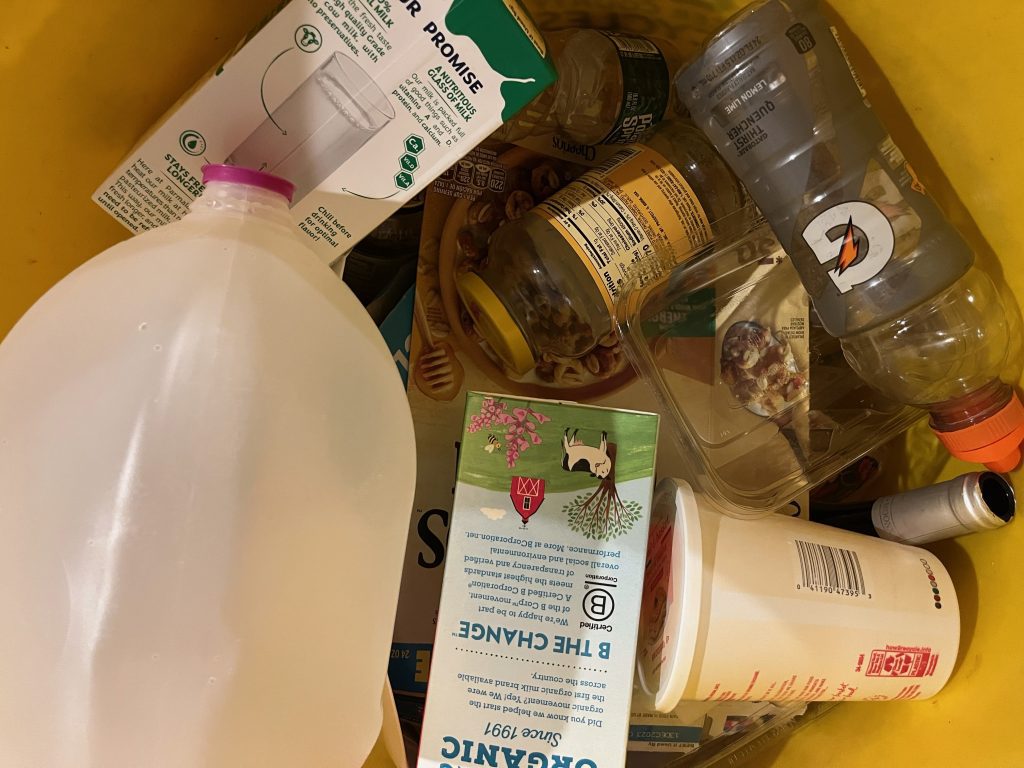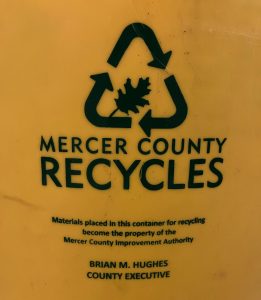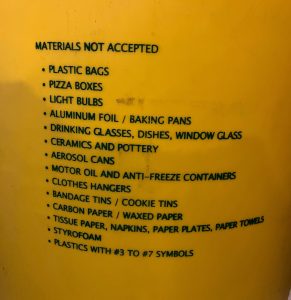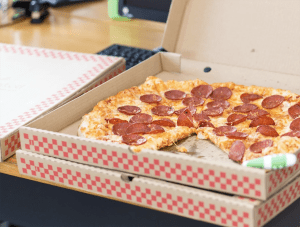Our Editor’s Conversation with Daniel G. Napoleon
 In the second issue ever of Princeton Perspectives back in April 2020, we included an article about the right way to recycle, Are You Doing it Right? Recycling 101. While we invite you to go back and refer to that article, there remains a lot of misinformation out there about recycling. 175 nations are currently working towards a legally binding agreement to end plastic pollution and this May, the United Nations issued a report detailing a roadmap of sorts to help get there. Part of that process is accelerating recycling, something that has been mandatory in New Jersey since 1987.
In the second issue ever of Princeton Perspectives back in April 2020, we included an article about the right way to recycle, Are You Doing it Right? Recycling 101. While we invite you to go back and refer to that article, there remains a lot of misinformation out there about recycling. 175 nations are currently working towards a legally binding agreement to end plastic pollution and this May, the United Nations issued a report detailing a roadmap of sorts to help get there. Part of that process is accelerating recycling, something that has been mandatory in New Jersey since 1987.
To understand what role Mercer County is playing in the recycling world, we asked Daniel G. Napoleon, the Director of Environmental Programs for the Mercer County Improvement Authority, to share insight and explanations to questions the community is pondering.
1. What role is Mercer County playing in the process to accelerate recycling?
Mercer County oversees a county-wide curbside recycling program that services 9 of the 12 municipalities. Participation in the shared service is optional for each municipality. In 2024 we will be servicing 10 of the 12 municipalities.
 2. How much is collected and recycled here annually?
2. How much is collected and recycled here annually?
In 2022 there were 26,998.05 tons of recyclable material collected in Mercer County. We recently conducted a waste study to determine our contamination rate. The study showed that of all the recycling material collected, 9% was contaminated and could not be recycled. Meaning that of the 26,998.05 tons of material collected through our program 24,568.22 tons of material was in fact recycled.
3. What happens once things are collected?
Recycling is collected curbside from the residents and taken to a processing facility where they use advanced technology and optical sorters that can recognize materials by their makeup, color, size, shape, etc. Once the material is sorted, it is bundled by material and sold to an end market.
4. Why does the county only collect plastics items labeled #1 or #2?
Recycling is a market driven industry. There are 7 grades of plastic, and each plastic has a different chemical compound which, for most grades, limits their ability to be recycled. Plastics #1 & #2 have a healthy end market and are the only plastics that are guaranteed to be recycled. Plastics #3 through #7 are not guaranteed to be recycled because there is currently no end market for their processing. Please note that there is currently a growing end market for #5 plastic but at this time that end market cannot process large quantities of #5 plastic material.
5. If you have a plastic item with a different number, is there something better one can do with it, rather than throw it in the trash?
Rather than immediately throwing non-recyclable plastics in the trash, Mercer County offers two possible solutions. One, Mercer County offers a free app called Recycle Coach that has a feature called “What Goes Where”. This feature allows residents to look up specific items they would like to dispose of and find the proper disposal method. Secondly, in addition to the app, Mercer County’s “Beyond the Bucket” manual highlights various non-curbside recycling material and where to dispose of such material. Both the App and the Manual can be found on our website www.mcianj.org
6. Are there any considerations of recycling more types of items?
Expansion of the accepted recycling material is mainly dependent upon the capability of an end market to handle processing the amount of material generated by a county-wide program. Should a long-term sustainable end market be developed, Mercer County will strongly consider expanding our list of acceptable recyclable materials.
7. There’s rumor that much of what’s collected isn’t even recycled. Is that true? If some plastic/paper items are collected, but not right for Mercer’s process, what happens to them?
Mercer County has one of the better contamination rates in the state of New Jersey at 9%. Meaning 91% of the material placed in the yellow bins is clean material that is able to be processed and sold to an end market. We can only account for the material that is placed in the recycling buckets. Many of the studies currently addressing material not being recycled are waste studies conducted at landfills – not at recycling processing facilities. Studies conducted at landfills include recyclable materials residents place in their trash and not in their recycling container.
 8. Recycling is good for the environment, but it’s also a business. Is that why only certain things get processed here?
8. Recycling is good for the environment, but it’s also a business. Is that why only certain things get processed here?
As stated previously, recycling is market driven. If there is no market to create something new with the material being processed, it ends up in the landfill. Collecting material that currently does not have an end market ends up doubling processing fees as the hauler pays to have the material processed at the recycling center and then the recycling center pays to have it taken to the landfill.
9. What does single stream recycling mean and why Mercer County do it?
Mercer County made the decision to convert from dual stream collection to that of single stream collection in 2010. The primary reason was to reduce overall operational costs. For example, single stream collection reduces the number of trucks collecting material which in turn reduces the number of workers, reduces the carbon footprint, and reduces the potential damage to roadways. The negative side of single stream is primarily the uptick in contamination in that residents place many non-recyclable materials in their containers.
 10. What’s the biggest mistake people make and what is the most important thing people should understand to help recycling work better?
10. What’s the biggest mistake people make and what is the most important thing people should understand to help recycling work better?
a) Currently, the largest contaminants in the recycling stream are plastic bags, pizza boxes, and lithium-ion batteries. Plastic bags are recyclable however, they are considered plastic film and need to be processed differently at the recycling facility. If placed in the recycling bucket, the bags are processed at a single stream recycling facility and get tangled in the sorting machinery causing shut down of operations on an average of 5 times daily. The multiple shutdowns create delayed processing times and create a safety hazard for employees who must go and manually cut out the material from the machines.
b) Most pizza boxes are full of grease. There is currently no way to separate that oil from the fibers in the cardboard pizza box. If there is a greasy cardboard box when the cardboard and paper go through the pulping process, the residual oil contaminates the rest of the material, and the end product can potentially have grease and oil residue.
c) Lithium-ion batteries should never be thrown on the back of any truck. They are a major fire hazard and have caused several fires in collection vehicles and at processing facilities nationwide. Currently, the trucks used by the hauler in Mercer County are natural gas trucks which adds to the importance of avoiding any material that could ignite a flame in the load.
11. Has New Jersey’s plastic bag ban had any impact on the recycling process?
Yes, there has been a significant decrease in plastic bags in the recycling stream. This reduction has decreased the amount of “stoppage/down” time at the facility and unnecessary delays.
12. Anything additional you want our readers to know/understand?
When in doubt, throw it out. “Wish-cycling” is a common topic of conversation throughout the industry. Residents “wish” something was recyclable or believe it should be, so they throw it in the recycling bin. While we understand the good intention behind “wish-cycling”, it ends up causing more harm than good by increasing contamination rates.

Daniel G. Napoleon is the Director of Environmental Programs for the Mercer County Improvement Authority. He is responsible for managing the overall operational aspects of the County’s Recycling Department and Environmental Initiatives. Dan is a certified Recycling professional and sits on the Board of Directors of both the Association of NJ Recyclers and the Solid Waste Association of North America- NJ Chapter.
